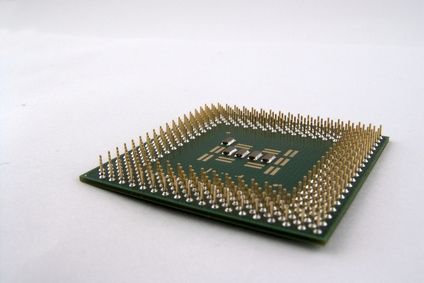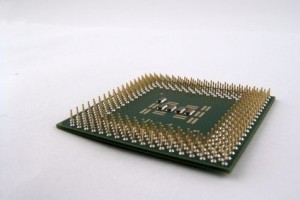All electronic devices, when at work, produce some amount of heat. Some devices produce more heat than others. One such such electronic that produces a good amount of heat is a computer CPU. The heat that is formed is generally very high, usually well over 100 degrees Fahrenheit, and should be checked specifically in computers which are used for long periods time or computers that are under heavy load.
The heat that is produced in a processor needs to properly dissipated. Heat has a damaging effect on the circuits of hardware and can cause decreased performance of the system.
How CPU Temperature is Controlled
In the past, computers needed to be placed in air conditioned rooms to control CPU temps. The ones used today do not need air conditioning, although they still should be used carefully in really hot environments. Computers today still benefit from cooler environments. For example, most server rooms are still kept in the low 70s or upper 60s.
For any desktop or laptop, a proper heat transfer system has to be in place. Heat transfer in the CPU is generally related to the internal workings. These often include heat-sinks and fans. As noted above, some servers are still kept in cool environments to reduce heat. Some extreme computers will even use water cooling to keep a CPU cool. Keeping this heat dissipating hardware running efficiently is very important.
Reasons for Overheating CPU
There are many things that can cause problems with heat dissipation or for excess heat to be generated. A dusty environment adds to the heating up of the system because the dust tends to clog up the important fans needed to dissipate heat. Sometimes improper installation of hardware or hardware failure can cause the CPU Temps to go to high. There is a special kind of problem, especially with the techies, called overclocking that is used in order to make the computer run faster than it was actually designed to run. This puts additional stress on the system, thus, generating more heat.
Monitoring CPU Temperature
Heat sensors are generally added to all key components of systems these days. For example, most CPUs, video cards, and hard drives will have heat sensors. Often times, you can find the temps of your hardware in the BIOS. However, it is usually helpful to be able to see the temperatures when you are in Windows or when running CPU intensive applications. For this, you can download a 3rd party tool such as Core Temp or Real Temp. These are both free and work quite well.
Lowering CPU Temperature
An easy and free thing you can do is to make sure that your computer case is clean and organized. Making sure that all fans are clean and running well can solve many overheating problems and can lower temperatures even if you don’t have an overheating problem. Another thing you can do is to add fans to the computer case to increase airflow. You can also place the PC in a cooler part of your house or apartment. Another easy tip is to turn off the computer when it is not in use. This can prevent overheating when you are not around to monitor the computer. If you still need more cooling power, you can upgrade your computer case to a case which is better designed for cooling. These cases are often a little bigger, have more fans, have bigger fans, and have better airflow design. One last thing you can do is to upgrade your CPU fan and heat-sink.
Maximum CPU Temperature
Below is a table that shows some of the top processors available in the market and the maximum temperature under which they can work efficiently. Please keep in mind that you want your processor to be running well BELOW these temperatures.
| Intel CPU Model | Maximum Temp | AMD CPU Model | Maximum Temp |
| Core Duo Models | 61-72 Degree Celsius (2 models can go to 100) |
Athlon 64 | 65 – 71 Deg. Celsius |
| Core Solo Models | 100 Degree Celsius | Athlon 64 FX | 56 – 63 Deg. Celsius |
| Pentium M Models | 100 Degree Celsius | Athlon 64 X2 | 63 – 75 Deg. Celsius |
| Core 2 Duo Models | 60 – 72 Degree Celsius | Sempron Soquete 462 | 90 Degree Celsius |
| Core 2 Quad Models | 62.2 Degree Celsius | Sempron Soquete AM2 | 55 – 69 Deg. Celsius |
| Core 2 Extreme | 64 – 100 Degree Celsius | Opteron 1XX | 65 – 70 Deg. Celsius |
| Pentium Dual Core | 73 – 100 Degree Celsius | Opteron 2XX | 67 – 71 Deg. Celsius |
| Intel i3 Series | 69-72 Degree Celsius | Phenom II | 62-65 Deg. Celsius |
| Intel i5 Series | 69-72 Degree Celsius | A Series | 69-73 Deg. Celsius |
| Intel i7 Series | 69-73 Degree Celsius | FX Series | 65 Deg. Celsius |
Overall, keeping an eye on processor temperature is important because a cooler processor is a faster processor. Also, if a processor heats up too much, it can be damaged, sometimes beyond repair.



Thanks for providing the temperature references. I’m currently troubleshooting a laptop with an i5 processor that is periodically shutting down. I used HWMonitor to monitor the CPU and GPU temps. It looks like my max temps are at or slightly below what you’ve listed above for the i5. Time to move on to the next theory! Thanks again.